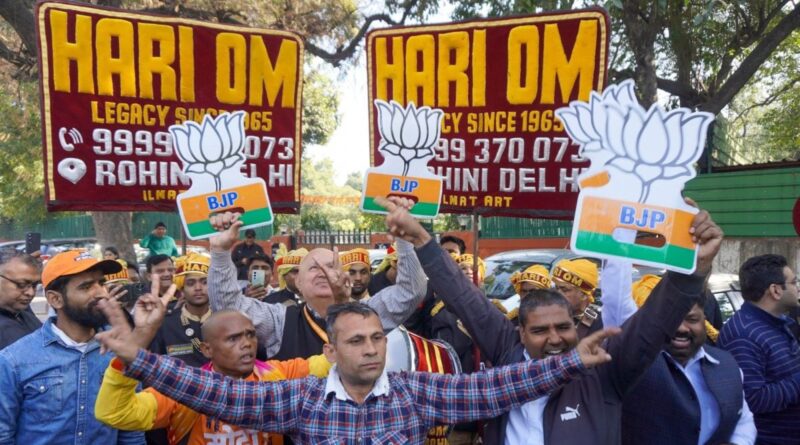SC Vote, Upset Middle Class & Freebies Masterstroke: How BJP Painted The Capital Saffron
Last Updated:
The BJP split the 20 per cent Dalit vote this time, which primarily lives in the jhuggis, and this hurt the AAP badly

BJP supporters celebrate as the party looks set to win the Delhi elections. (PTI)
The Delhi elections seem to have brought a decisive mandate for the Bharatiya Janata Party (BJP), ending its 27-year-long power drought in the national capital, and ending the over-decade-long rule of the Aam Aadmi Party (AAP). How did BJP achieve this miracle after being in a nearly 15 per cent vote deficit from the AAP in the last assembly elections? Let’s decode the factors.
The SC Vote In Jhuggis
For over a decade, the poor in Delhi’s jhuggis and clusters have sworn by AAP. With free power and free water, this is a constituency that AAP has nurtured and has been its trump card in elections. But this time, BJP made some inroads among the poor in the jhuggis.
An extensive campaign, the promise of a pucca house to everyone in the jhuggis, and the promise to continue free water and power is what gave BJP a look-in here. The BJP split the 20 per cent Dalit vote this time, which primarily lives in the jhuggis, and this hurt the AAP badly. This was a hat-trick for the BJP after Dalits returned to its fold in Haryana and Maharashtra as well post the 2024 Lok Sabha election campaign when the Congress narrative of “Constitution is in danger” had worked.
Counter-Polarisation To Muslim Vote
In Delhi, there is a 13 per cent Muslim Vote, and at least nine seats where Muslim voters are pre-dominant. For over a decade now, the Muslims have consolidated in Delhi behind the AAP, bringing the party big victories. But this time, BJP’s biggest victories are coming in seats like Mustafabad and Karawal Nagar which were riot-affected areas in 2020. Both Mohan Singh Bisht and Kapil Mishra have registered big victories on these seats. There seems to have been strong counter-polarisation in these seats in favour of the BJP though the Congress could not do major damage in form of a split. Further, the Purvanchali vote moved to BJP in a big way.
The Middle Class Support
Delhi’s middle class forms 40 per cent of the voters. Traditionally, this vote bank in a big measure has split between the BJP and AAP but this time, on the ground, they have consolidated for the BJP. The reasons are many — the city’s failing infrastructure, air pollution and state of the Yamuna, potholed roads, poor drinking water quality and garbage lying on roads and streets. BJP, this time, actively reached out to RWAs, market associations, and traders to get them fully on board. The middle class in Delhi feels that AAP has only worked for the poor, and ignored the former. The 8th Pay Commission announcement is another positive for the BJP, as a large number of government employees are based in Delhi as voters. Another bonus was the Budget announcement that those earning till Rs 12.75 lakh will not need to pay any income tax under the new regime.
As a result, BJP has swept nearly all the seats of Outer Delhi which border Haryana and Uttar Pradesh and nearly all of Western Delhi.
Freebies Masterstroke
From 2020, when BJP termed AAP’s freebies as ‘revadis’ and it back-fired as people thought BJP would end free power and free water facilities, Narendra Modi’s party has changed its strategy and said no free schemes will be stopped if it comes to power. Additionally, the BJP promised Rs 2,500 per month for women with a date given for implementation to counter Arvind Kejriwal’s new promise of Rs 2,100 per month for women after these elections. With such promises, the BJP split AAP’s core vote base in the jhuggis of Delhi and also got the women voter in some measure back from the AAP. The woman voters, whose voting percentage outnumbered that of men in 41 seats of Delhi, seem to have rewarded the BJP this time because of the freebie promises by the saffron party.
Modi As BJP Face
AAP seemed to have an advantage here with Arvind Kejriwal the unquestioned chief ministerial face for the party. He had clearly said he will replace Atishi as the CM if AAP wins. But the Narendra Modi appeal seems to have outshined all, even though BJP offered no clear CM face. The sheen of Kejriwal was gone, given the various corruption scams and the ‘Sheesh Mahal’ controversy hurting his image of ‘simple living and high thinking’. The BJP’s biggest face, PM Narendra Modi, made a fervent appeal to Delhi’s voters to give his party a chance after a long gap of 27 years. He has promised a double-engine government to put an end to the constant bickering between the Kejriwal government and the Centre, and promised to put Delhi on the fast path of development. The BJP fought a constituency-to-constituency election, sensing the anti-incumbency against Arvind Kejriwal this time.

